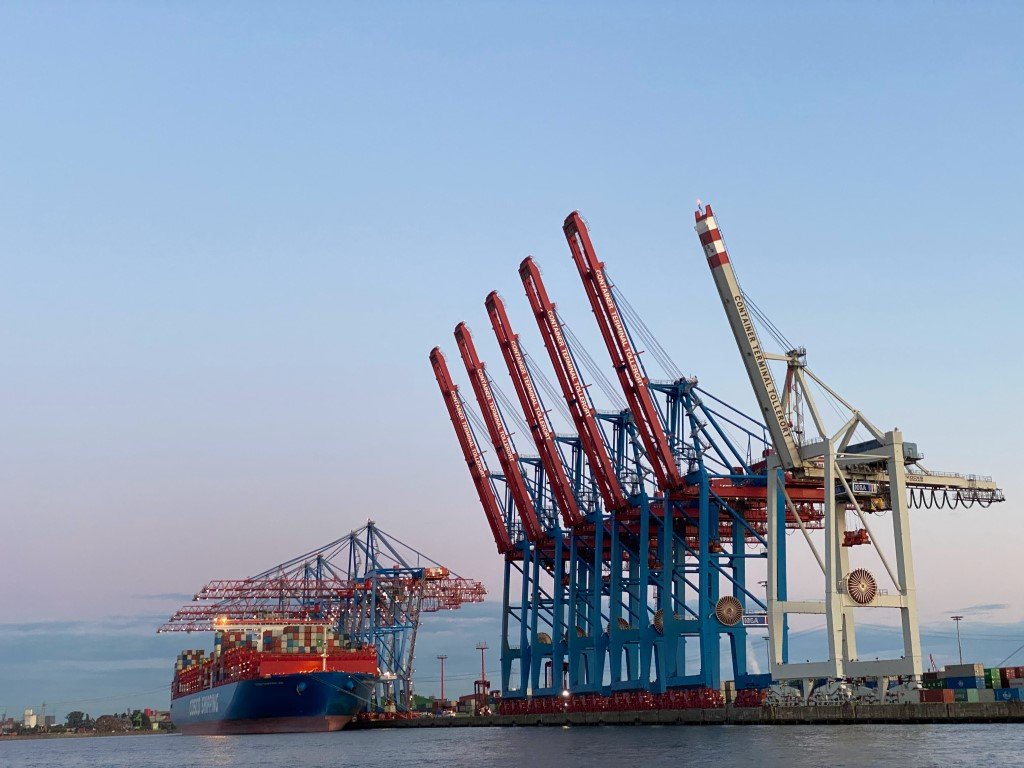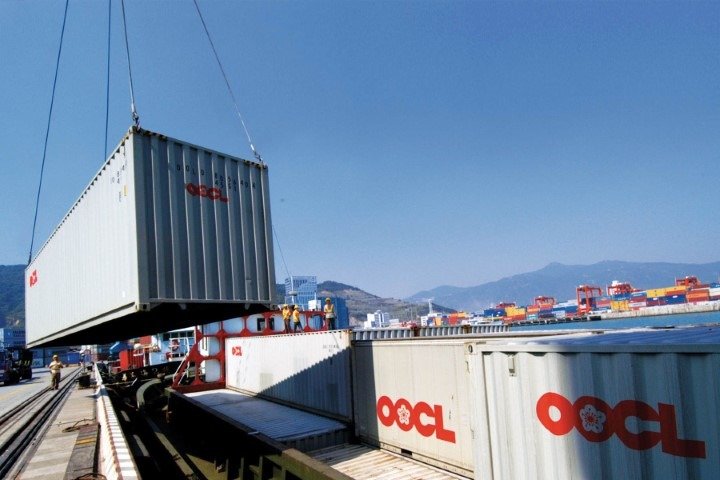Container ships, the workhorses of international trade, play a pivotal role in transporting goods across the world’s oceans. Have you ever wondered how fast these mammoth vessels move across the vast expanse of water?
In this comprehensive article, we delve into the intriguing world of container ship speeds. From the factors influencing their velocity to the implications for global trade, we’ve got you covered. So, let’s set sail and explore the captivating journey of container ships!

How Fast Do Container Ships Travel?
Container ships, often referred to as cargo ships or freighters, can vary in speed depending on multiple factors. On average, these ships travel at a speed of around 20 to 25 knots (23 to 29 mph or 37 to 46 km/h). However, it’s important to note that this speed can fluctuate based on various elements that come into play during a voyage.
Also Read, Why Containers Ships are Faster than Tankers and Bulk Carriers
Factors Influencing Container Ship Speeds
Several key factors influence the speed of container ships. These include:
1. Ship Design and Size
The design and size of a container ship can significantly impact its speed. Modern ships are designed for efficiency, with streamlined hulls that reduce water resistance and improve speed. Larger ships, known as ultra-large container vessels (ULCVs), tend to have lower speeds due to their massive size and increased cargo capacity.
2. Engine Power
The engine power of a container ship determines how swiftly it can navigate through the water. Ships with more powerful engines can maintain higher speeds, especially when facing adverse weather conditions or strong ocean currents.
3. Weather Conditions
Weather plays a crucial role in dictating a ship’s speed. Favorable weather conditions, such as calm seas and moderate winds, allow container ships to maintain consistent speeds. On the other hand, storms, heavy waves, and strong winds can slow down vessels to ensure crew safety and prevent damage to cargo.
4. Cargo Load
The weight and distribution of cargo on a container ship can impact its speed. A heavier load can lead to decreased speed due to increased water resistance and higher fuel consumption.
5. Ocean Currents
Ocean currents have a significant effect on a ship’s speed, especially during long voyages. Ships can either benefit from favorable currents, which boost their speed, or face challenges when moving against strong currents.
6. Fuel Efficiency
In an era of environmental consciousness, fuel efficiency has become a vital consideration. Container ships often adjust their speed to optimize fuel consumption, striking a balance between timely delivery and economical operation.
You may also like,
- Top 10 Biggest Container Shipping Companies in World (2023)
- What is Twistlock Lashing System on Container Ships
- Everything about Container Ships
- The Evolution of Ships – From Wooden Boats to Modern Vessels
Impact on Global Trade

The speed of container ships has a profound impact on global trade dynamics. Here’s how:
Container ships are the lifelines of international trade, facilitating the movement of goods across continents. The speed at which these ships travel affects supply chains, manufacturing processes, and consumer access to products.
Did you know? The concept of “slow steaming” emerged as a strategy to enhance fuel efficiency by reducing ship speeds. While it extends voyage times, it contributes to cost savings and reduced carbon emissions.
In the era of just-in-time manufacturing and e-commerce, timely delivery of goods is crucial. Faster ships enable businesses to meet consumer demands promptly and keep shelves stocked with the latest products.
Fuel Consumption by Containership Size and Speed
Fuel consumption by a containership is mostly a function of ship size and cruising speed, which follows an exponential function above 14 knots. For instance, while a containership of around 8,000 TEU would consume about 225 tons of bunker fuel per day at 24 knots. At 21 knots, this consumption drops to about 150 tons per day, a 33% decline.

While shipping lines would prefer consuming the least amount of fuel by adopting lower speeds, this advantage must be mitigated with longer shipping times as well as assigning more ships on a pendulum service to maintain the same port call frequency. The main ship speed classes are:
- Normal (20-25 knots; 37.0 – 46.3 km/hr). Represents the optimal cruising speed a containership and its engine have been designed to travel at. It also reflects the hydrodynamic limits of the hull to perform within acceptable fuel consumption levels. Most containerships are designed to travel at speeds around 24 knots.
- Slow steaming (18-20 knots; 33.3 – 37.0 km/hr). Running ship engines below capacity to save fuel consumption but at the expense of an additional travel time, particularly over long distances (compounding effect). This is likely to become the dominant operational speed as more than 50% of the global container shipping capacity operated under such conditions as of 2011.
- Extra slow steaming (15-18 knots; 27.8 – 33.3 km/hr). Also known as super slow steaming or economical speed. A substantial decline in speed to achieve a minimal fuel consumption level while still maintaining a commercial service. It can be applied to specific short-distance routes.
- Minimal cost (12-15 knots; 22.2 – 27.8 km/hr). The lowest speed technically possible, since lower speeds do not lead to any significant additional fuel economy. However, the level of service is commercially unacceptable, so it is unlikely that maritime shipping companies would adopt such speeds.

The practice of slow steaming emerged during the financial crisis of 2008-2009 as international trade and the demand for containerized shipping plummeted at the same time as new capacity ordered during boom years was coming online.
As a response, maritime shipping companies adopted slow steaming and even extra slow steaming services on several of their pendulum routes. It enabled them to accommodate additional ships with a similar frequency of port calls. It was expected that as growth resumed and traffic picked up, maritime shipping companies would return to normal cruising speeds.
However, in an environment of higher fossil fuel prices, maritime shipping companies are opting for slow steaming for cost-cutting purposes but using the environmental agenda to justify them further. Slow steaming practices have become the new normal to which users must adapt.
Advancements in Container Ship Speeds
With the continual advancement of maritime technology, the speed of container ships is evolving. The introduction of new propulsion systems, improved hull designs, and enhanced engine efficiency is pushing the boundaries of maritime speed capabilities.
FAQs
Q: Do container ships always travel at the same speed?
A: No, container ship speeds can vary based on factors like ship size, weather conditions, and cargo load.
Q: Why do some container ships travel slower than others?
A: Slower speeds can result from factors such as larger ship size, fuel efficiency considerations, and adverse weather conditions.
Q: How do ocean currents affect container ship speeds?
A: Favorable ocean currents can boost ship speeds, while strong currents can hinder progress.
Q: What is “slow steaming”?
A: “Slow steaming” is a strategy that involves reducing ship speeds to enhance fuel efficiency and reduce emissions.
Q: How do container ship speeds impact global trade?
A: Faster ship speeds enable timely delivery of goods, supporting supply chains and consumer access to products.
Q: What advancements are being made in container ship speeds?
A: Advancements in propulsion systems, hull designs, and engine efficiency are driving improvements in container ship speeds.
Conclusion
Container ships are the backbone of global trade, and their speed is a crucial factor that influences supply chains, consumer access to products, and environmental considerations. From the intricate interplay of ship design and weather conditions to the advancements in maritime technology, the world of container ship speeds is a dynamic and ever-evolving one.
As we sail towards the future, these mighty vessels will continue to navigate the oceans, fostering worldwide connections and ensuring the smooth flow of goods.

